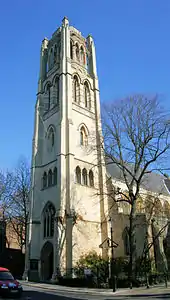All Saints Notting Hill
All Saints Notting Hill is a Church of England parish church in Talbot Road, Notting Hill, London. It is a Victorian Gothic Revival stone building with polychromatic decoration. The west tower has five stages with the stump of a spire, and the chancel has paintings by Henry Holiday.[1][2]
| All Saints Notting Hill | |
|---|---|
 Illustration of the interior of the newly completed church in 1866 | |

| |
| Location | Talbot Rd, London |
| Country | United Kingdom |
| Denomination | Church of England |
| Churchmanship | Anglo-Catholic |
| Website | All Saints Notting Hill |
| History | |
| Founder(s) | Samuel Walker |
| Dedication | All Saints |
| Associated people | Walter Passmore |
| Architecture | |
| Heritage designation | Grade II* |
| Designated | 29 July 1949 |
| Architect(s) | William White, with Sir George Gilbert Scott |
| Style | Gothic Revival |
| Years built | 1861 |
| Administration | |
| Deanery | Kensington and Chelsea |
| Archdeaconry | Kensington |
| Episcopal area | Kensington |
| Diocese | London |
| Province | Canterbury |
| Clergy | |
| Priest(s) | Philip Corbett SSC SSC |
| Curate(s) | Bello Mahilum |
| Laity | |
| Reader(s) | Gladvin Allen |

The church was badly damaged by enemy action during World War II but was fully restored by 1951. It is a Grade II* listed building.[3]
History
Building of All Saints' Church was begun in 1852 for the Reverend Dr Samuel Walker, to designs by architect William White, working with Sir George Gilbert Scott. The church was to be the centrepiece of the development now known as Colville and Powis Squares. Walker was deeply religious and his vision was for a church without pew rents for the newly-built neighbourhood.[4]
Walker ran short of money and was eventually declared bankrupt. The building was left unfinished for several years, lacking a spire, and remaining unfurnished, in which time it was nicknamed "All-Sinners-in-the-Mud".[5]
All Saints was eventually completed in 1861 for the Reverend John Light of Trinity College Dublin, at a cost of £25,000.[6] The spire in White's original designs was never completed.[4]
The tower is 100 feet (30 m) high and is said to resemble the Medieval Gothic Belfry of Bruges, Belgium.[7]
Walter Passmore (1867–1946), a singer and actor best known for his comic baritone roles in Gilbert and Sullivan operas with the D'Oyly Carte Opera Company, was a choirboy at All Saints.[8]
World War II and The Blitz
All Saints suffered serious bomb damage in The Blitz of World War II,[1] along with neighbouring buildings including Pinehurst Court, at 1–9 Colville Gardens. The first bombs fell on 26 September 1940, and the church was hit again in March and June 1944. The Lady chapel and the south transept chapel were destroyed.[4] Restoration work was completed in 1951.
Clergy
From 1931 to 1961 the vicar was the flamboyant Fr John Twisaday, who established the high church worship tradition at All Saints. The present vicar is Fr Philip Corbett SSC, who was inducted in 2019. All Saints' parish is part of the Anglo-Catholic Forward in Faith movement.[9]
Vicars
- 1861–85 John Light
- 1885–96 Robert Trench
- 1896–1907 Philip Herbert Learyk
- 1907–31 Herbert Ridley
- 1932–61 John Herbert Cloete Twisaday
- 1961–66 John Herbert Brewer
- 1966–67 John Henry Dixon
- 1967–74 Peter Clark
- 1976–2018 John Brownsell
- 2019- Philip Corbett
Notes

- Pevsner 1952, p. 297.
- Historic England. "All Saints Church, Clydesdale Road W11 (1080701)". National Heritage List for England. Retrieved 20 February 2010.
- Historic England. "All Saints Church (Grade II*) (1080701)". National Heritage List for England. Retrieved 5 August 2015.
- Denny 1993, p. 70
- Shepherd 1973, pp. 298–332.
- "All Saints' Church Notting Hill". The Illustrated London News. 8 September 1866. p. 245. Retrieved 20 February 2010.
- Mitton 2007, p. 97.
- Walters, Michael, ed. (1995). "Gilbertian Gossip". Gilbert and Sullivan Newsletter Archive. Department of Mathematics, Boise State University. Retrieved 20 February 2010.
- "Homepage". All Saints Notting Hill. Retrieved 5 August 2015.
References
- Denny, Barbara (1993). Notting Hill and Holland Park Past. Historical Publications. p. 70. ISBN 0-948667-18-4.
- Mitton, Geraldine (2007). The Kensington District. Project Gutenberg. (EBook 21643)
- Pevsner, Nikolaus (1952). London. The Buildings of England. 2 Except the Cities of London and Westminster. Harmondsworth: Penguin Books. ISBN 0-14-071006-X.
- Shepherd, FHW, ed. (1973). The Portobello and St Quintin estates. Survey of London. 37 Northern Kensington. London: London County Council. pp. 298–332.
External links
| Wikimedia Commons has media related to All Saints Notting Hill. |